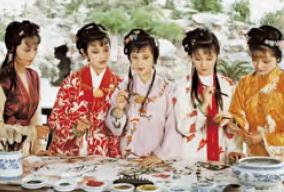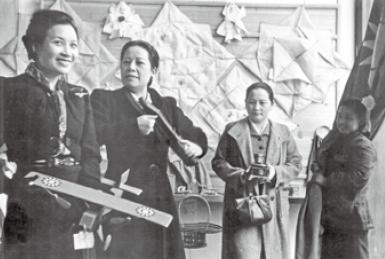For the main part of China’s history, women were dominated by a patriarchic system and forced to a background role. Only in recent history have they reached a more equal position in Chinese society and started to visibly shape the countries destiny. We take a look at how woman have stepped out of the shadows to become one of the pillars of China’s current development success.

Girls in rich families were taught poetry, instruments, singing, calligraphy and maintaining their beauty, not to self-entertainment or pleasure, but to become a desirable bride, capable of entertaining their future husband out
As in every great culture, women have played an important role in shaping and moving China's history. However, for the greater part of the nearly 5000 years, women had to sit in the back seat and were confined to the shadows of the countries great developments.
For thousands of years, women have been part of a feudalist, patriarchic msociety dominated by a strict hierarchy of men. The female poet Tsai Yen clearly outlines this relationship around 200 A.D.: In childhood, a female must be subject to her father, in youth to her husband, when her lord is dead to her sons – a woman must never be independent.
A woman’s life was aligned along the rules and needs of men and the extended family. The birth of a boy was generally more valued as that of a girl. Raising a girl meant, that the family would have to find a husband – involving the bride’s family offering an expensive dowry to the groom – and then having her leave the family forever. Daughters were therefore considered costly and of little value to increase a family’s wealth or influence. Independent of a family’s social status, a woman’s main purpose was to bare children – preferably sons – and to take care of husband, elders and children. Despite that, the role and duties would vary strongly, depending on how wealthy or cultured the family was. While poorer families were depending on the women as a working force, daughters of wealthy families would have a very different life. While their poorer counterparts at least had the freedom to leave the house for work, these “high daughters” were locked inside the family mansion. It was inappropriate for a woman of notable family to be seen by people – especially men – outside the family circle.
Empresses in China

Chinese historical female emperor in Tang Dynasty, Empress Wu Zetian
However restricted women’s rights might have been, they did have their strong and influential positions within the family system as leaders of the household, as manipulating concubines or matrons or as the men’s background advisors or clever wedding match-makers. Three women even came to lead the Middle Kingdom (China). The first one was Lü Zhi (around 185 B.C.) during Han Dynasty. The second was Wu Zetian (625-705 A.D.). The only real Empress in Chinse history. She managed to come to power through a series of clever intrigues and murder plots and then set out to reform and restructure the then faulty governmental administration system. She was one of the driving forces open the notoriously difficult administrational exams – through which the government recruited its administrators – to any Chinese, regardless of his social status or background. An effort which paid off, since China’s government could then recruit the best and brightest of its subjects instead of only such from noble decent. The infamous CiXi was the third woman to rule China on behalf of her son for almost 30 years. Her name is largely connected to the late days of the decay of the Middle Kingdom. Through the pressure from foreign powers and amounting economic and political problems, she was forced to modernize and open China, an attempt which came to late and couldn’t prevent the several thousand year old Kingdom to fall apart.
Early 1900s: Shanghai, the Paris of the East

Song sisters, the most influential women in recent China, at the military aeroplane donation, 1942
With the fall of the last Emperor and the new rule of the Republicans under Tschiang Kai-Shek at the beginning of the 20th Century came a wave of modernization and with it some faint reforms, giving women more freedom and rights. In the booming trading city of Shanghai for example – then called “the Paris of the East” – women could be spotted wearing Western clothes and stylish Qi Pau enjoying coffee, wine and dancing in Jazz clubs. The time was also an early bloom for young female writers such as Zhang “Eileen” Ailing (1920-95), who in her stories portrayed very strong, self-confident women who knew what they wanted. Yet in business or politics, women were still a rare attraction.
Mao and Post Mao era:women hold up half of the sky in China
This should change drastically after Mao Zedong and the Communist Party gained power and founded the People’s Republic of China in 1949. Of the many political programs Mao implemented during his era, the liberation of women can be seen as one of China’s most important changes, which still have a highly positive effect today. “Times have changed, and today men and women are equal. Whatever men comrades can accomplish, women comrades can too.” This reform brought women out of their domestic confinements onto the streets, into factories, schools and universities, the army and into political posts. As the communist ideology tried to level social inequality, it also tore down many dividing walls between men and women. Foot binding, restrictive laws on marriage and divorce, and other forms of oppression against women were abolished. The structures of the housewife and mother caring for household, relatives and kids had been in part replaced by government structures such as day-care centers for kids or dining-halls for factory workers. Had the dream woman in Qing dynasty traditionally been a frail object of desire and a “toy” for men, the communist role model was now a strong woman working side by side with male comrades, erased of all fragility or sex-appeal. Women suddenly appeared in leading political posts or as leaders within a factory or commune structure – unknown before in China. What remained however was the expectation to bare many children, preferably boys.
The post-Mao era and the opening of China towards the West and the many reforms in economy and education triggered an unparalleled development of societal change. Women also strongly benefited in terms of their position in society and their options in work and life. While the saying “women hold up half of the sky in China” might be exaggerated, in the vast majority of Chinese families, both husband and wife are working full time. A large portion of the Chinese work force – from factories to the service industry – are women. Today the majority of students at Chinese universities are female. China's maturing socialist market economy and the government's support have contributed a lot to women's achievements. Statistics show that women run about 20 percent of China's companies and around 46 percent of these female-managed enterprises in China have appeared since 1995.

A strong woman working side by side with male comrades, erased of all fragility or sex-appeal” painting of Mao Era
In only one century China’s women have come a long way. A century which through historic turmoil and political reform has shaken up social structures that had prevailed for thousands of years and had kept Chinese women from unfolding their full potential. Today they’re on track to get what they deserve and to play an important role in shaping China’s future.





